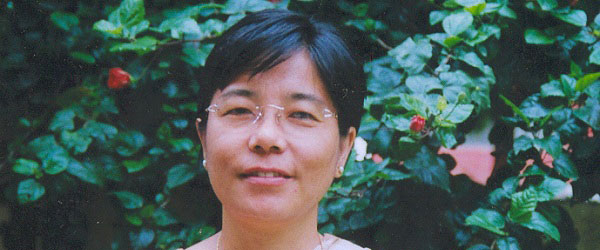JYOTSNA SITLING – THE WOMAN WHO SAVED THE VALLEY OF FLOWERS

An entire mountain region would have turned into a garbage dump. A National Park would have been left to degenerate and rendered useless. A hill range would have lost an unimaginable soil cover. Thousands of people would have lost their livelihood. All this had it not been for a woman of substance named Jyotsna Sitling, who did some of the most commendable jobs in public service.
Jyotsna Sitling is the first female tribal IFS officer. In 2002 Jyotsna Sitling joined the Nanda Devi Biosphere in Uttarakhand as a Director. She had a herculean task at hand. She was given 5800 acres of land to manage. It consisted of two National Parks, and a sanctuary to revive. Jyotsna Sitling had the toughest of jobs in the most beautiful of lands.
With an unmatched landscape, boasting of the rarest of fauna and flora, the 19 km trail leads to Hemkund Sahib (the highest Gurudwara in the world). The Valley of Flowers National Park offers some of the most fascinating and pleasing landscapes nature has to offer. Despite all this, there was a problem. Pilgrims were leaving behind plastics, garbage and other dumps and this would continue for more than three decades. People were choking and getting suffocated, unable to breathe due to the stink.
Jyotsna Sitling decided to change the environment and she became the catalyst for the change. She called for a Garbage Collection Initiative. The initiative was a great success and they collected up to fifteen truckloads of garbage (weighing up to 50 tonnes). The entire valley started getting rid of its pollutants and the entire collection of garbage was sent for recycling.
Jyotsna Sitling knew that just achieving a temporary change would not serve the purpose. To bring the change, she would need to develop strategies and create plans to sustain the change. She figured out that out of multiple challenges that lay ahead, two challenges had to be tacked first as they were the major contributors to the land being misused.
Jyotsna Sitling realized that there were around 400 unorganized shops which were one of the large contributors to polluting the trek trail. She started speaking to all these shop owners and families. For almost seven consecutive days she kept convincing and explaining the pros and cons of the action. She was finally able to convince the shop owners to have one shop per family and thus stopped the misutilization of land and uneven distribution of livelihood. She was able to bring the number of shops down from almost 400 to just 76 and thus the first challenge was taken care of.
Another challenge was that the forest officials and local authorities were not on good terms. Jyotsna Sitling then spent a lot of time with both the parties and with her wit and wisdom, was able to show the benefit and economic gain for both the parties if they worked together. She was successful in bridging the animosity and building a better relationship.
Jyotsna Sitling introduced several checks to sustain the newly found change. She developed an Eco Development Committee (EDC) consisting of local stakeholders from villages. She introduced several initiatives like renting raincoats to pilgrims during the rainy season, putting a ban on the usage of plastics, and encouraging the usage of brown paper. She also advised the shopkeepers to keep products, especially for children and babies so that they don’t suffer. She also developed plans to create a continuous influx of money and she also worked out a plan to create insurance plans for pilgrims. This created new livelihood ideas for the locals and people were happy.
In the year 2004, Jyotsana Sitling is credited to have put together an entire guideline for mountaineering in Uttarakhand. As the Director, she was instrumental in creating several pathbreaking initiatives to develop the Nanda Devi Biosphere Reserve between 2002 to 2004. What really worked for her was her firm belief that markets should work for the environment, and the community should be the real stakeholder. The guideline created by Jyotsna Sitling and her team is the first of its kind in any state in India.
Jyotsna Sitling’s hard work paid off and her supporters were jubilant when UNESCO declared the Valley of Flowers a World Heritage Site.
Jyotsna Sitling’s passion for her work is legendary. For her determination, courage, resilience and duty towards nature, she was awarded the prestigious Indira Gandhi Paryavaran Puraskar which is the country’s highest honour in this regard given to anyone to date. She was also awarded the Prime Minister’s Award for Excellence in Public Administration (2006-07) for her outstanding contribution to public service. She is currently serving as the Principal Chief Conservator of Forests – Van Panchayat with the Government of Uttarakhand.
Credits and suggested further reading:
https://positive-vibes.co.in/Blog/Jyotsna-Jyotsna Sitling-Transformed-the-Valley-of-Flowers-from-a-Dumping-Ground-to-a-World-Heritage-Site.php
https://www.thebetterindia.com/5904/tbi-heroes-jyotsna-Jyotsna Sitling-a-green-warrior/
https://milaap.org/stories/unsung-heroes-jyotsna-Jyotsna Sitling-daughter-of-nature

